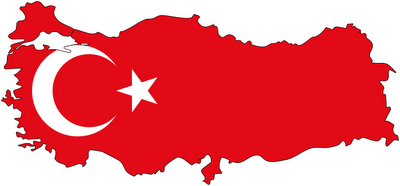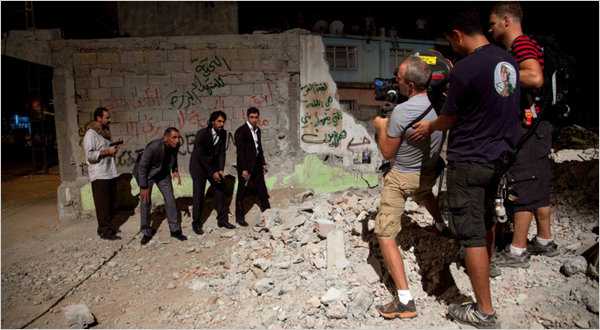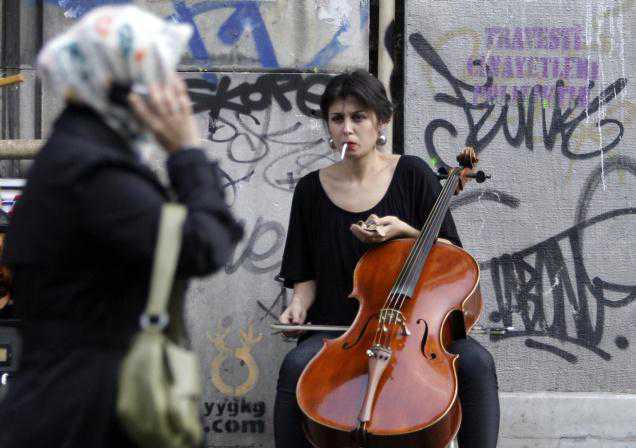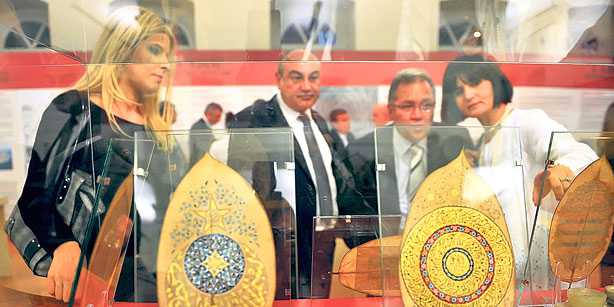BY RICHARD HELM, POSTMEDIA NEWS NOVEMBER 20, 2010
Turkish writer Orhan Pamuk insists he’s not the sad soul his writings would have us assume, despite considerable regretful evidence to the contrary.
Pamuk was in Edmonton this weekend as part of the University of Alberta’s Festival of Ideas, a congress of notable writers and thinkers brought together to speak on the general theme of “truth and lies.” Pamuk was one of three Nobel laureates on the festival’s guest list, having secured that literary honour back in 2006. He is the author of such books as My Name is Red, Snow, Istanbul: Memories and the City, and The Museum of Innocence, his latest novel, recently released in paperback.
Pamuk, 58, once wrote that except for those hours he spends writing, life to him seems “flawed, deficient and senseless.” So it was with little surprise that I found him a somewhat distant conversationalist during a brief telephone interview the other day.
Readers can get their best grasp of Pamuk from his 2005 memoir, Istanbul, which recounts his upbringing in a city of ruins and end-of-empire melancholy – a city where Pamuk still spends much of his time. The epigraph Pamuk chose to open the book is by Turkish writer Ahmet Rasim: “The beauty of a landscape resides in its melancholy.” It is this preoccupation with the melancholy Turkish soul, this sense that they’re a nation and a people that’s been left out of history, that is most often associated with Pamuk’s writings.
“Look, I grew up exposed to the ruins of the Ottoman Empire, and Turkey then, in the 1950s and ’60s, was extremely poor compared to what it is today,” Pamuk said, speaking from his office at Columbia University in New York, where he lectures on literature for one semester each year.
“So that of course lends itself to feelings of sadness, melancholy, textures of decay. But Istanbul ends in 1970, almost 40 years past. The country has got richer and it is not that melancholy now. It is now, especially as a tourist destination, a colourful, interesting place. But then I’m not only writing for the tourists, I’m writing for the poor Istanbul, the historical Istanbul. There’s not only the touristy Turkey, there is also the real Turkey.”
The real Turkey recently approved via referendum a series of amendments to the country’s constitution to bring it more in line with European Union standards. Pamuk, who was charged but never prosecuted in 2005 for having “publicly denigrated Turkish identity” for public comments regarding the 1915 Armenian genocide, said he welcomes the slow transition to a more liberal and open Turkish society.
“I don’t think the European Union wants to see Turkey getting more Islamist, so I’m happy with the results of the referendum.”
But he was obviously less inclined to talk politics than literature, specifically his newest projects. The Naive and the Sentimental Novelist, just out this month, collects the Norton Lectures Pamuk gave at Harvard late last year, in which he sets out his thoughts about writing and the wisdom imparted by the “secret centre” buried in literary works.
Pamuk says he’s currently working on an epic novel of “the big Istanbul” of today, the one with a population that has ballooned by 11 million since the author’s birth.
“I’m trying to capture the feelings, lives, chronicles of all these peoples who moved from the poorer parts of Turkey to Istanbul, the cultural, industrial centre. How they lived there, how they survived, how they built up their shantytowns, how they got to be rich, how some failed, the kind of novel that has ambitions of being epic, describing the rule of urban change in Turkey.”
It has been said that Pamuk’s latest novel, The Museum of Innocence, is his most accessible work. It tells the story of a tragic, obsessive love between the scion of a bourgeois Istanbul family and a poorer distant relation. Accessible, perhaps, but not really upbeat, I suggest to Pamuk.
“It’s not melancholy. It’s about love. There is a sadness there too, but it’s the sadness of a love story, not of cultural decay, of the failure of empire.”
Pamuk has said he plans to open a real-life Museum of Innocence in Istanbul, which will display the same keepsakes – salt shakers, door knobs, porcelain figurines – that his fictional protagonist Kemal collects over the years in pursuit of his unattainable love.
Nothing remotely melancholy there.
It seemed like the sort of oddball venture worth asking about. Is it true the ephemera will include 4,214 cigarette butts and 237 hair barrettes?
Pamuk didn’t want to talk about it.
Edmonton Journal
rhelm@edmontonjournal.com
© Copyright (c) Postmedia News
via Melancholy man: On Turkish writer Orhan Pamuk..
 A cultural heritage cataloging project, “Inventory of Cultural Heritage and Cultural Economy of Istanbul,” has been ongoing in Turkey’s capital over the past 16 months. Through a partnership between the Ministry of Tourism and Culture, the Istanbul 2010 Capital of Culture Agency, and other institutions, the project seeks to categorize and inventory “every sort of cultural heritage” into an accessible online database. The 2010 project, much like its failed predecessors, is an ambitious one: with Istanbul’s centuries-old history dating from the Roman Empire and rich cultural legacy of diverse inhabitants, the comprehensive digital archive is expected to number in the millions. A small budget of only TL 1,512,000 (2.2 millions USD) complicates the endeavor even further.
A cultural heritage cataloging project, “Inventory of Cultural Heritage and Cultural Economy of Istanbul,” has been ongoing in Turkey’s capital over the past 16 months. Through a partnership between the Ministry of Tourism and Culture, the Istanbul 2010 Capital of Culture Agency, and other institutions, the project seeks to categorize and inventory “every sort of cultural heritage” into an accessible online database. The 2010 project, much like its failed predecessors, is an ambitious one: with Istanbul’s centuries-old history dating from the Roman Empire and rich cultural legacy of diverse inhabitants, the comprehensive digital archive is expected to number in the millions. A small budget of only TL 1,512,000 (2.2 millions USD) complicates the endeavor even further.




